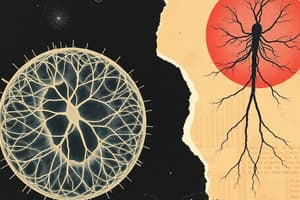Podcast
Questions and Answers
What is a characteristic common to all living organisms?
What is a characteristic common to all living organisms?
- Ability to regulate body temperature
- Ability to carry out movement (correct)
- Ability to reproduce
- Ability to respond to stimuli
What type of movement involves the capture of prey?
What type of movement involves the capture of prey?
- Ventilation
- Motility
- Locomotion (correct)
- Internal movement
What is a characteristic of motile organisms?
What is a characteristic of motile organisms?
- Ability to reproduce
- Ability to respond to stimuli
- Ability to actively move from one place to another (correct)
- Ability to carry out photosynthesis
What is an example of a motile organism?
What is an example of a motile organism?
What is a function of the cheetah's long tail?
What is a function of the cheetah's long tail?
What is a characteristic of sessile organisms?
What is a characteristic of sessile organisms?
What is an example of a sessile organism?
What is an example of a sessile organism?
How do sessile organisms obtain food and resources?
How do sessile organisms obtain food and resources?
What triggers a response in the Venus flytrap?
What triggers a response in the Venus flytrap?
What happens after the Venus flytrap's trap closes?
What happens after the Venus flytrap's trap closes?
Flashcards are hidden until you start studying
Study Notes
Movement in Living Organisms
- Movement is a universal feature of living organisms and one of the key processes of life.
Types of Movement
- Internal movement: movement of materials within a cytoplasm, such as ventilation in the lungs.
- Locomotion: movement from one location to another, allowing organisms to capture prey, obtain abiotic resources, and more.
Motile Organisms
- Motile organisms have the ability to actively move from one place to another.
- Examples: animals, such as mammals, birds, and insects.
- Functions of locomotion: avoiding danger, finding a mate, migrating, foraging for food.
- Means of locomotion: skeletal muscles, wings, flagella (whip-like structures in bacteria).
Sessile Organisms
- Sessile organisms are fixed to one place once they have established a location.
- They rely on the environment to bring food and other resources to them.
- Examples: plants, some animals, such as sea anemones.
- Movement in response to external stimuli: growth of a plant stem towards light.
Examples of Motile and Sessile Organisms
- Cheetah: fastest animal on land, can run up to 120 km per hour, adapted backbone and long tail for smooth locomotion.
- Venus flytrap: carnivorous plant, feeds on insects, traps close in response to touching hairs on its surface, digests insects with enzymes.
Studying That Suits You
Use AI to generate personalized quizzes and flashcards to suit your learning preferences.



